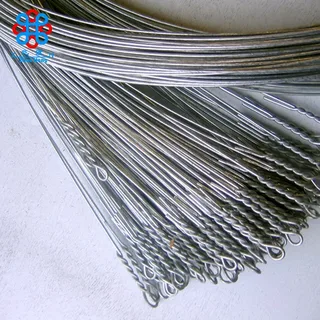Tie wire is a highly versatile material used in a wide range of industries, especially in construction and do-it-yourself (DIY) tasks. Known for its flexibility, strength, and ease of use, tie wire serves as an essential tool for fastening, securing, and bundling materials. In this article, we explore the top 10 applications of tie wire in construction and DIY projects, shedding light on how this simple material can solve complex problems.
1. Rebar Tying in Concrete Work
One of the most common applications of tie wire is in reinforcing concrete structures. Tie wire is used to secure rebar (reinforcing bars) in place before concrete is poured. This ensures the rebar stays in the correct position, providing the structural integrity required in buildings, bridges, and other concrete structures.
2. Fencing Installation and Repair
Tie wire is widely used in installing and repairing fences. It can secure wire mesh, chain links, or barbed wire to fence posts, providing stability and ensuring long-term durability. It’s also handy for quick fixes when sections of a fence become loose or damaged.
3. Electrical Cable Management
In electrical work, tie wire is an effective way to organize and secure bundles of electrical cables and conduit piping. It prevents cables from tangling and helps electricians maintain neat and safe installations.
4. Scaffold Fastening
Safety is paramount in construction, and tie wire plays a vital role in securing scaffolding components. Workers use tie wire to fasten metal bars or tubes, ensuring that scaffold structures remain stable during use.
5. Securing Insulation Materials
Another important use of tie wire is in holding insulation materials in place. Whether it’s thermal or acoustic insulation, tie wire can be used to fasten materials to walls, ceilings, or pipes, ensuring that they stay firmly attached.
6. Temporary Fixes and Quick Repairs
In both construction and home improvement, tie wire is the go-to solution for temporary fixes. Need to fasten a loose pipe or hang a broken gate temporarily? Tie wire offers a strong, adjustable, and quick solution.
7. DIY Home and Garden Projects
Tie wire is incredibly popular in DIY projects. From making plant supports in the garden to creating simple wire sculptures or hanging decorations, the possibilities are endless. Its ease of manipulation makes it a favorite among hobbyists.
8. Hanging and Mounting Tools or Equipment
In workshops and garages, tie wire is used to create hooks or loops for hanging tools. It’s a cheap and effective way to organize workspaces without needing specialized hangers or brackets.
9. Binding Building Materials
During construction or remodeling, tie wire is often used to bundle and bind items like wood, pipes, or steel rods for transport or storage. It keeps materials neat, accessible, and prevents them from scattering.
10. Supporting Frameworks in Masonry
Lastly, tie wire supports temporary frameworks in masonry work, such as bricklaying or plastering. It helps hold guide wires, straight edges, or support bars in place during construction, ensuring precision and stability.
Conclusion
From heavy-duty construction tasks to creative DIY solutions, tie wire proves to be an invaluable tool across a wide array of applications. These top 10 applications of tie wire in construction and DIY projects demonstrate its incredible adaptability and usefulness. Whether you are a professional contractor or a weekend DIY enthusiast, keeping a roll of tie wire in your toolbox is always a smart choice.
Looking to get more out of your materials? Start exploring the top 10 applications of tie wire in construction and DIY projects, and you’ll be amazed at the number of problems it can solve!


